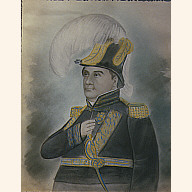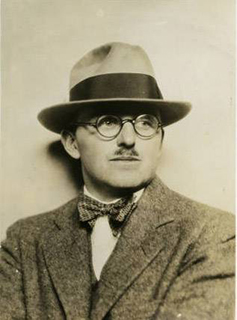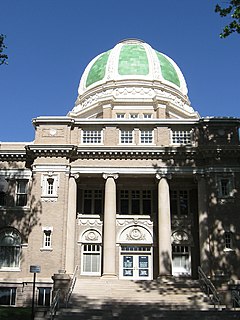
Interstate 25 (I-25) is a major Interstate Highway in the western United States. It is primarily a north–south highway, serving as the main route through New Mexico, Colorado, and Wyoming. I-25 stretches from I-10 at Las Cruces, New Mexico to I-90 in Buffalo, Wyoming. It passes through or near Albuquerque, New Mexico; Pueblo, Colorado; Colorado Springs, Colorado; Denver, Colorado; and Cheyenne, Wyoming. The I-25 corridor is mainly rural, especially in Wyoming, excluding the Albuquerque, Pueblo, Colorado Springs, and Denver metropolitan areas.

Las Animas County is a county located in the U.S. state of Colorado. As of the 2020 census, the population was 14,555. The county seat is Trinidad. The county takes its name from the Mexican Spanish name of the Purgatoire River, originally called El Río de las Ánimas Perdidas en el Purgatorio, which means "River of the Lost Souls in Purgatory."

Las Animas is the Statutory City that is the county seat, the most populous community, and the only incorporated municipality in Bent County, Colorado, United States. The city population was 2,410 at the 2010 United States Census. Las Animas is located on the Arkansas River, just west of its confluence with the Purgatoire River, in southeast Colorado east of Pueblo, near the historic Bent's Fort.

C. W. & George L. Rapp, commonly known as Rapp & Rapp, was an American architectural firm famed for the design of movie palaces and other theatres. Active from 1906 to 1965 and based in Chicago, the office designed over 400 theatres, including the Chicago Theatre (1921), Bismarck Hotel and Theatre (1926) and Oriental Theater (1926) in Chicago, the Five Flags Center (1910) in Dubuque, Iowa and the Paramount Theatres in New York City (1926) and Aurora, Illinois (1931).

Ratón Pass is a 7,834 ft (2,388 m) elevation mountain pass on the Colorado–New Mexico border in the western United States. It is located on the eastern side of the Sangre de Cristo Mountains between Trinidad, Colorado and Raton, New Mexico, approximately 180 miles (290 km) northeast of Santa Fe. Ratón is Spanish for "mouse". The pass crosses the line of volcanic mesas that extends east from the Sangre de Cristo Mountains along the state line, and furnishes the most direct land route between the valley of the Arkansas River to the north and the upper valley of the Canadian River, leading toward Santa Fe, to the south. The pass now carries Interstate 25 and railroad tracks.

Manuel Armijo was a New Mexican soldier and statesman who served three times as governor of New Mexico. He was instrumental in putting down the Revolt of 1837, he led the force that captured the Texan Santa Fe Expedition, and he later surrendered to the United States in the Mexican–American War, leading to the Capture of Santa Fe.

John Gaw Meem IV was an American architect based in Santa Fe, New Mexico. He is best known for his instrumental role in the development and popularization of the Pueblo Revival Style and as a proponent of architectural Regionalism in the face of international modernism. Meem is regarded as one of the most important and influential architects to have worked in New Mexico.

The Pueblo Revival style or Santa Fe style is a regional architectural style of the Southwestern United States, which draws its inspiration from Santa Fe de Nuevo México's traditional Pueblo architecture, the Spanish missions, and Territorial Style. The style developed at the beginning of the 20th century and reached its greatest popularity in the 1920s and 1930s, though it is still commonly used for new buildings. Pueblo style architecture is most prevalent in the state of New Mexico, it is often blended with the Territorial Revival architecture.

Hoehne is an unincorporated town, a post office, and a census-designated place (CDP) located in and governed by Las Animas County, Colorado, United States. The Hoehne post office has the ZIP Code 81046. At the United States Census 2010, the population of the Hoehne CDP was 111.

The New Mexico Museum of Art is an art museum in Santa Fe governed by the state of New Mexico. It is one of four state-run museums in Santa Fe that are part of the Museum of New Mexico. It is located at 107 West Palace Avenue, one block off the historic Santa Fe Plaza. It was given its current name in 2007, having previously been referred to as The Museum of Fine Arts.
The Santa Fe Trail Scenic and Historic Byway is a 188-mile (303 km) National Scenic Byway and Colorado Scenic and Historic Byway located in Prowers, Bent, Otero, and Las Animas counties, Colorado, USA. The byway follows the Santa Fe National Historic Trail through southeastern Colorado and connects to the 381-mile (613 km) Santa Fe Trail Scenic Byway in New Mexico at Raton Pass, a National Historic Landmark at elevation 7,834 feet (2,388 m). The byway visits Amache National Historic Site and Bent's Old Fort National Historic Site, both National Historic Landmarks, and winds between the Spanish Peaks and Raton Mesa, both National Natural Landmarks.

The Scottish Rite Temple, also known as Scottish Rite Cathedral or Santa Fe Lodge of Perfection, in Santa Fe, New Mexico was begun in 1911 and completed in 1912. It was a filming location for the 2016 Tina Fey film Whiskey Tango Foxtrot.

First Christian Church is a historic church at 200 S. Walnut Street in Trinidad, Colorado.
Willard Carl Kruger (1910–1984) was an American architect born in Sperry, Texas, who grew up in Raton, New Mexico. He founded W. C. Kruger and Associates, which was an American architectural and engineering firm. The firm designed a number of Los Alamos buildings, as part of the Manhattan Project.

The Chaves County Courthouse, located on the 400 block of Main Street in Roswell, New Mexico, is the center of government of Chaves County. The courthouse was built in 1911 after Roswell's citizens learned that New Mexico would become a state the next year. Isaac Hamilton Rapp, of the Colorado firm I.H. and W.M. Rapp, designed the courthouse in the "monumental civic" adaptation of the Beaux-Arts style. A cupola with green tiles tops the courthouse.
Charles William Bulger was an architect in the United States, born in Delphi, Indiana. He worked with Isaac Rapp in Trinidad, Colorado, at Bulger and Rapp for several years, designing many of the city's early buildings. The firm dissolved in 1892.
Edward Alfred Harrison, known as E. A. Harrison, was an American architect who worked as a staff architect for the Atchison, Topeka & Santa Fe Railway, with offices in Topeka, Kansas, and later in Chicago, Illinois.
This is a list of protests in New Mexico related to the murder of George Floyd.













